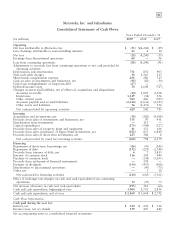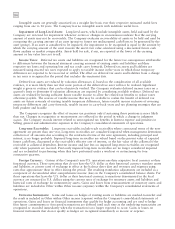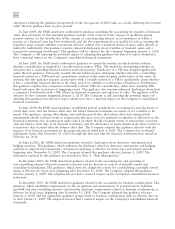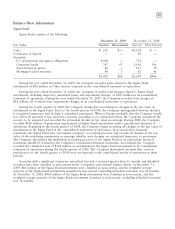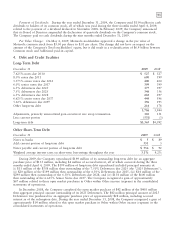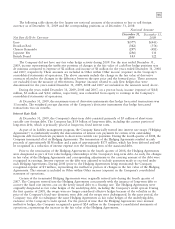Motorola 2009 Annual Report Download - page 93
Download and view the complete annual report
Please find page 93 of the 2009 Motorola annual report below. You can navigate through the pages in the report by either clicking on the pages listed below, or by using the keyword search tool below to find specific information within the annual report.
85
Earnings (Loss) Per Share: The Company calculates its basic earnings (loss) per share based on the
weighted-average effect of all common shares issued and outstanding. Net earnings (loss) attributable to
Motorola, Inc. is divided by the weighted average common shares outstanding during the period to arrive at the
basic earnings (loss) per share. Diluted earnings (loss) per share is calculated by dividing net earnings (loss)
attributable to Motorola, Inc. by the sum of the weighted average number of common shares used in the basic
earnings (loss) per share calculation and the weighted average number of common shares that would be issued
assuming exercise or conversion of all potentially dilutive securities, excluding those securities that would be
anti-dilutive to the earnings (loss) per share calculation. Both basic and diluted earnings (loss) per share amounts
are calculated for earnings (loss) from continuing operations and net earnings (loss) attributable to Motorola, Inc.
for all periods presented.
Share-Based Compensation Costs: The Company has incentive plans that reward employees with stock
options, stock appreciation rights, restricted stock and restricted stock units, as well as an employee stock
purchase plan. The amount of compensation cost for these share-based awards is measured based on the fair
value of the awards, as of the date that the share-based awards are issued and adjusted to the estimated number
of awards that are expected to vest. The fair value of stock options, stock appreciation rights and the employee
stock purchase plan is generally determined using a Black-Scholes option pricing model which incorporates
assumptions about expected volatility, risk free rate, dividend yield, and expected life. Compensation cost for
share-based awards is recognized on a straight-line basis over the vesting period.
Retirement Benefits: The Company records annual expenses relating to its pension benefit and
postretirement plans based on calculations which include various actuarial assumptions, including discount rates,
assumed asset rates of return, compensation increases, turnover rates and health care cost trend rates. The
Company reviews its actuarial assumptions on an annual basis and makes modifications to the assumptions based
on current rates and trends. The effects of the gains, losses, and prior service costs and credits are amortized over
future service periods. The funding status, or projected benefit obligation less plan assets, for each plan, is
reflected in the Company’s consolidated balance sheets using a December 31 measurement date.
Advertising Expense: Advertising expenses, which are the external costs of marketing the Company’s
products, are expensed as incurred. Advertising expenses were $412 million, $790 million and $1.1 billion for the
years ended December 31, 2009, 2008 and 2007, respectively.
Use of Estimates: The preparation of the accompanying consolidated financial statements in conformity
with accounting principles generally accepted in the U.S. requires management to make estimates and assumptions
about future events. These estimates and the underlying assumptions affect the amounts of assets and liabilities
reported, disclosures about contingent assets and liabilities, and reported amounts of revenues and expenses. Such
estimates include the valuation of accounts receivable and long-term receivables, inventories, Sigma Fund,
investments, goodwill, intangible and other long-lived assets, legal contingencies, guarantee obligations,
indemnifications, and assumptions used in the calculation of income taxes, retirement and other post-employment
benefits and allowances for discounts, price protection, product returns, and customer incentives, among others.
These estimates and assumptions are based on management’s best estimates and judgment. Management evaluates
its estimates and assumptions on an ongoing basis using historical experience and other factors, including the
current economic environment, which management believes to be reasonable under the circumstances. We adjust
such estimates and assumptions when facts and circumstances dictate. Illiquid credit markets, volatile equity,
foreign currency, energy markets and declines in consumer spending have combined to increase the uncertainty
inherent in such estimates and assumptions. As future events and their effects cannot be determined with
precision, actual results could differ significantly from these estimates. Changes in those estimates resulting from
continuing changes in the economic environment will be reflected in the financial statements in future periods.
Reclassifications: Certain amounts in prior years’ financial statements and related notes have been
reclassified to conform to the 2009 presentation.
Recent Accounting Pronouncements: In October 2009, the Financial Accounting Standards Board (‘‘FASB’’)
issued new accounting guidance related to the recognition of revenue for multiple-deliverable arrangements. Under
the new guidance, revenue may be allocated to the different elements in an arrangement based on relative
estimated sales price. In October 2009, the FASB issued new accounting standards altering the scope of revenue
recognition guidance for software deliverables to exclude items sold that include hardware with software that is
essential to the hardware’s functionality. This new guidance will be effective prospectively for revenue
arrangements entered into or materially modified in fiscal years beginning on or after June 15, 2010. Early
adoption is permitted. The Company is still assessing the potential impact of adopting this new guidance, but








